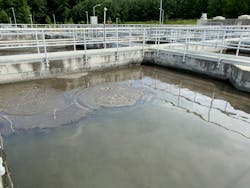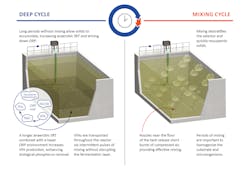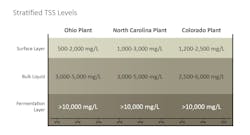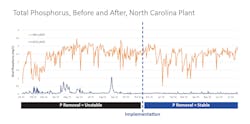Enhanced fermentation: An effective approach to phosphorus removal
Regulatory changes throughout the United States drive municipal wastewater treatment plants (WWTPs) to continually improve their approaches to phosphorus removal. Treating wastewater to meet specific effluent limits can substantially reduce nitrogen and phosphorus discharge, which protects natural bodies of water and prevents disastrous ecological impacts on marine habitats.
Enhanced biological phosphorus removal 101
Enhanced biological phosphorus removal (EBPR) is the process by which naturally occurring organisms in the wastewater accumulate phosphorus under the right conditions as they travel through the treatment plant (see Figure 1). The microbes that accumulate phosphorus are named phosphorus accumulating organisms (PAOs).
In activated sludge processes with consecutive anaerobic and aerobic environments, PAOs thrive. In the anaerobic phase, PAOs consume carbon in the form of volatile fatty acids (VFAs), and release stored phosphorus as an energy source.
The EBPR process is sensitive to influent characteristics. The adequacy of surplus VFAs in the anaerobic selector is particularly crucial to achieving consistent EBPR. The ratio of biochemical oxygen demand to total phosphorus (BOD:TP) in the bioreactor influent is commonly used as indicator of a plant’s ability to achieve EBPR.
If the influent BOD:TP is lower than 25:1, it is known as carbon-limited, and sufficient VFAs may not be available, resulting in ineffective EBPR. A few common causes of carbon limited conditions are weak or diluted influent, excessive BOD removal in primary clarifiers, and significant recycled phosphorus from sludge processing operations.
To avoid costly carbon addition, facilities with insufficient influent VFAs can encourage additional VFA production through fermentation generated by in-line methods within the main process or by using sidestream methods. PAOs constitute a small subset of the bacterial population in the mixed liquor.
The rest of the bacteria do not consume VFAs; if given time during fermentation, they break down complex soluble organic compounds to form VFAs. As the fermentation blanket forms, VFA is produced and consumed by PAOs. Therefore, the fermentation process simultaneously conditions PAOs and provides an environment for VFA production.
When the PAOs run out of stored phosphorus, they cannot accept more VFA — i.e., they are full. To maximize the process, the surplus VFA must be transported out of the fermentation blanket to the hungry PAOs in the upper layers of the reactor.
PAOs store food under anaerobic conditions and then process the stored food under aerobic conditions. After passing through the anaerobic selector, the activated sludge enters an aerobic zone where PAOs use the VFA they have consumed as an energy source for phosphorus uptake. Phosphorus uptake in the aerobic environment is significantly greater than phosphorus release in the anaerobic zone, resulting in lower effluent levels.
Technology for EBPR
During the non-mixed deep cycle, a fermentation blanket forms and VFAs are produced. PAOs in the blanket consume the VFAs, while releasing stored phosphorus. The deep cycle not only generates VFAs, but it also delivers intermittent pulses to redistribute microorganisms and VFAs without disrupting the fermentation layer. Redistribution is accomplished through short, gentle pulses of compressed air. These pulses transport the VFAs upward without resuspending the blanket or disrupting the fermentation process. Overall, this gentle pulsing helps keep PAOs and VFA happily in balance, resulting in an abundant PAO population.
During the mixing cycle, the fermentation blanket is uniformly suspended to discourage methanogenic activity and recharge the blanket with organic matter for more VFA production. Utilizing BioMix compressed gas mixing, large bubbles are released through engineered nozzles near the floor of the tank, creating an upwelling motion and circulatory currents to completely mix the reactor.
In 2022, BioMix-DC was selected as a Water Environment Federation (WEF) Innovative Technology Award winner. Each year, WEF recognizes technologies and companies who have introduced new and innovative products or services related to the water and wastewater industry.
Compared to continuous mechanical mixing in anaerobic selectors, BioMix-DC provides energy savings of 90% or greater. It is adaptable and compatible with in-line mixed liquor fermentation, sidestream return activated sludge fermentation, and sidestream mixed liquor fermentation.
The proof is in the data
Once the factors that lead to successful EBPR are understood, measuring that success can be relatively straightforward. Using samples collected from multiple BioMix-DC installations across the U.S., the data demonstrates how plants are achieving environments with low oxidation reduction potential (ORP), fermentation blanket formation, VFA production, and high levels of phosphorus release in anaerobic selectors.
When mixing is suspended, the biomass settles and accumulates at the bottom of the tank. A sludge blanket forms, creating a fermentation layer. Accumulating solids create a higher concentration of sludge, which, in turn, increases the anaerobic mass fraction and solids retention time. Over time, the fermentation layer produces VFAs through the processes of hydrolysis and fermentation.
Total suspended solids (TSS) data from three different plants (see Figure 4) show distinct, stratified layers. The data from these plants demonstrate a well-established fermentation blanket.
When PAOs consume VFAs, they release phosphorus. To verify this, concentrations of ortho-phosphate (PO4) were measured in the influent and in the fermentation blanket (see Figure 6). The measurements in the blanket were 10 to 100 times higher than the concentrations found in the influent, confirming high levels of VFA consumption and substantial phosphorus release. Subsequent luxury phosphorus uptake follows in the aerobic reactors, resulting in low levels of effluent total phosphorus.
Prior to the implementation of BioMix-DC, the effluent phosphorus at the North Carolina plant was inconsistent. After implementation, the performance stabilized, resulting in consistent effluent quality with fewer spikes in phosphorus.
In addition to the nutrient removal benefits, BioMix-DC also delivers a net energy savings of 90% through the combination of eliminating mixing for long periods of time and the use of a high efficiency compressed gas mixing system.
Substantial savings are also realized by plants that need to supplement EBPR with carbon addition and/or chemical dosing for precipitation, specifically for plants that have low influent BOD:TP ratios or low influent VFAs. A reduction in chemicals used for precipitation directly results in reduced sludge volumes, and subsequently reduced sludge disposal costs.
Steps to Successful EBPR
Simply stated, to ensure EBPR success, WWTPs need to:
- Establish an anaerobic selector with oxidation-reduction potential consistently below -200 mV.
- Allow mixed liquor to settle, creating a fermentation blanket with longer anaerobic solids retention time.
- Promote conditions for fermentation and hydrolysis for volatile fatty acids generation.
- Encourage phosphorus release in the anaerobic reactor.
About the Author
Sarah Elger
Sarah Elger, P.E. is the director of strategy and marketing at EnviroMix Inc. She has been in the water and wastewater industry for more than 15 years and specializes in biological wastewater treatment and process controls. Sarah received her B.S. in engineering mechanics from University of Wisconsin; received her M.S. in environmental engineering from Milwaukee School of Engineering; and is a registered professional engineer in the State of Wisconsin.








